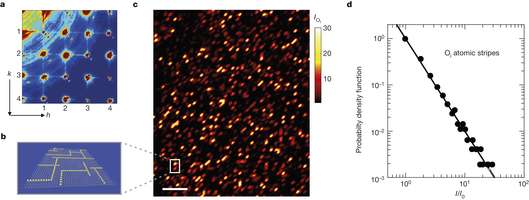September 17, 2015 report
X-ray images of cuprate superconductors reveals fractures , clumps and defects

(Phys.org)—A team of researchers with members from several countries in Europe has used a type of X-ray diffraction to reveal defects in the way a superconductor develops. In their paper published in the journal Nature, the team describes the technique they used to study one type of superconductor and what they saw. Erica Carlson with Perdue University offers a News & Views piece on the work done by the team in the same journal issue.
As scientists continue with efforts to discover a superconductor that can work at room temperature, they are also studying the properties of superconductors that have already been found, a necessary prerequisite to actually using superconductors in real-world applications. In this latest effort, the researchers used scanning micro X-ray diffraction to study the structure of a copper oxide superconductor as electrons were flowing through it. As Carlson notes, the technology allowed for viewing electron-density distribution, which prior research had shown, at the quantum level, the material looked like stripped wallpaper. Instead of uniform striping however, which the team expected, they observed a mish-mash of clumps of various shapes. Further research showed that the density of the clumps was related to the how much doping was used to create the material.
Carlson further explains that the findings by the team are important for two reasons: connectivity and dimensionality. The first could have implications for the transfer of charge between different domains, possibly serving as a hindrance to flow, making such materials impractical for use. Also the odd shapes appear to reduce dimensionality options which could wind up causing superconductors to behave differently than has been theorized. Complicating things is that the clumps appear to follow a power law, which suggests they may form in a way similar to fractals—electron behavior in such structures is not very well understood.
The findings by the team suggest the path to understanding superconductors may be more complex than has been thought, though it also appears they may offer opportunities that have not yet been discovered. More work needs to be done—Carlson suggests a better observation of the morphology of the path that electrons take as they move through the material, should help.
More information: Inhomogeneity of charge-density-wave order and quenched disorder in a high-Tc superconductor, Nature 525, 359–362 (17 September 2015) DOI: 10.1038/nature14987
Abstract
It has recently been established that the high-transition-temperature (high-Tc) superconducting state coexists with short-range charge-density-wave order and quenched disorder arising from dopants and strain. This complex, multiscale phase separation invites the development of theories of high-temperature superconductivity that include complexity. The nature of the spatial interplay between charge and dopant order that provides a basis for nanoscale phase separation remains a key open question, because experiments have yet to probe the unknown spatial distribution at both the nanoscale and mesoscale (between atomic and macroscopic scale). Here we report micro X-ray diffraction imaging of the spatial distribution of both short-range charge-density-wave 'puddles' (domains with only a few wavelengths) and quenched disorder in HgBa2CuO4 + y, the single-layer cuprate with the highest Tc, 95 kelvin. We found that the charge-density-wave puddles, like the steam bubbles in boiling water, have a fat-tailed size distribution that is typical of self-organization near a critical point. However, the quenched disorder, which arises from oxygen interstitials, has a distribution that is contrary to the usually assumed random, uncorrelated distribution. The interstitial-oxygen-rich domains are spatially anticorrelated with the charge-density-wave domains, because higher doping does not favour the stripy charge-density-wave puddles, leading to a complex emergent geometry of the spatial landscape for superconductivity.
Journal information: Nature
© 2015 Phys.org




















